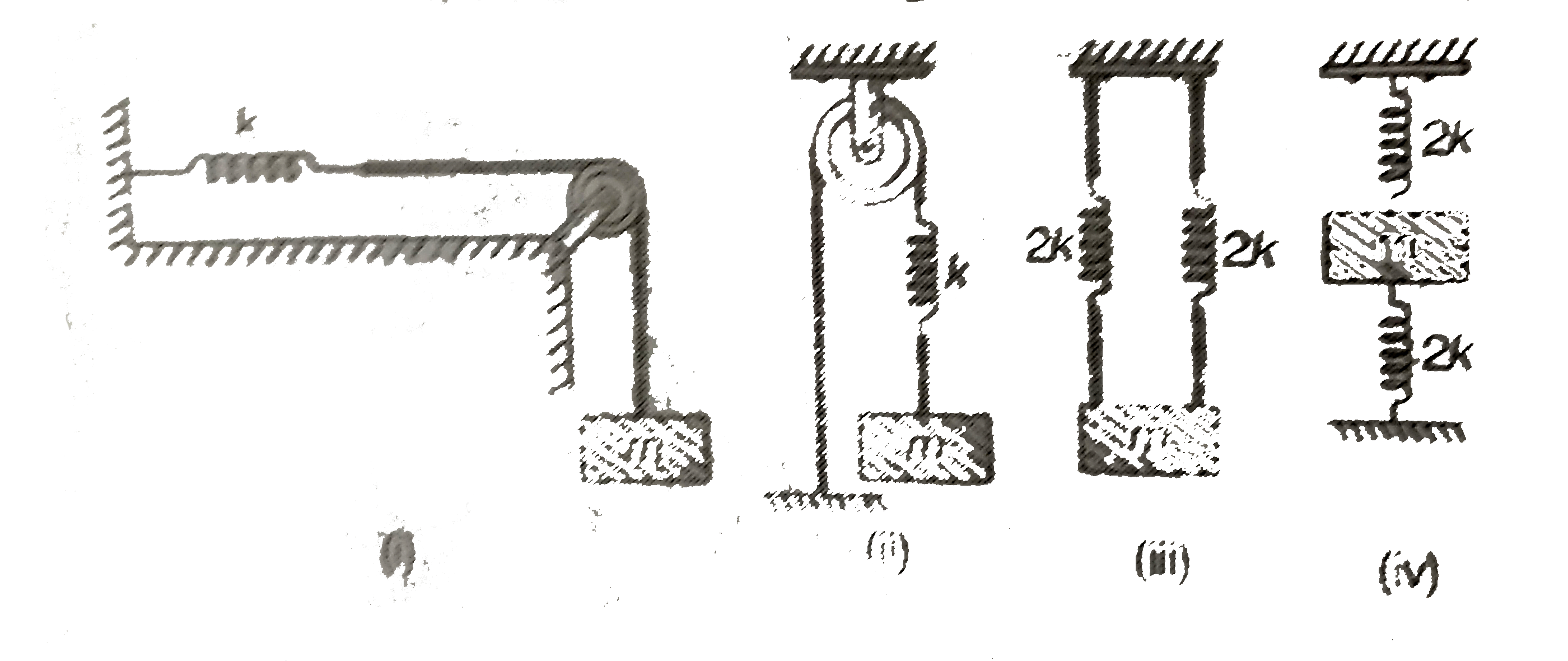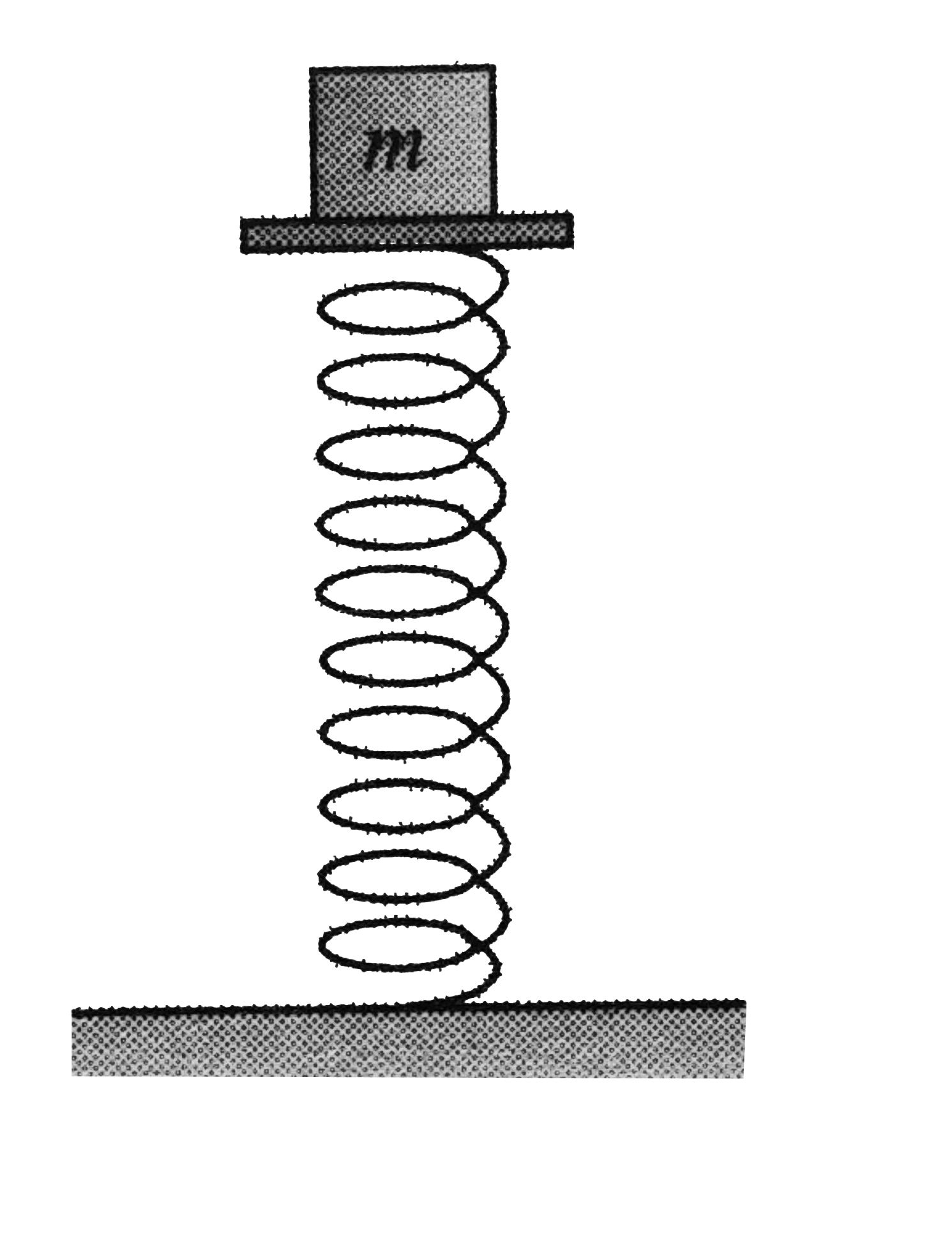A block of mass m suspended from a spring of spring constant k. Find the amplitude of S.H.M.
To find the amplitude of simple harmonic motion (SHM) for a block of mass m suspended from a spring with spring constant k, we can follow these steps:
1. Understand the Setup:
- We have a mass m attached to a spring with spring constant k.
- When the mass is suspended, it stretches the spring by an amount x0 from its equilibrium position.
2. Identify Forces:
- The force due to gravity acting on the mass is Fg=mg, where g is the acceleration due to gravity.
- The spring exerts a restoring force Fs=kx when it is stretched by x.
3. Equilibrium Condition:
- At the point of maximum elongation x0, the forces are balanced:
mg=kx0
4. Potential Energy Consideration:
- At the maximum elongation x0, all the gravitational potential energy is converted into elastic potential energy of the spring.
- The gravitational potential energy at this point is:
PEg=mgh=mgx0
- The elastic potential energy stored in the spring is:
PEs=12kx20
5. Applying the Work-Energy Theorem:
- According to the work-energy theorem, the gravitational potential energy is equal to the elastic potential energy at the maximum elongation:
mgx0=12kx20
6. Rearranging the Equation:
- Rearranging the equation gives:
kx20=2mgx0
- Dividing both sides by x0 (assuming x0≠0):
kx0=2mg
7. Solving for Amplitude x0:
- Finally, we solve for x0:
x0=2mgk
Final Answer
The amplitude of the simple harmonic motion (SHM) is:
Amplitude (A)=2mgk
- We have a mass m attached to a spring with spring constant k.
- When the mass is suspended, it stretches the spring by an amount x0 from its equilibrium position.
- The force due to gravity acting on the mass is Fg=mg, where g is the acceleration due to gravity.
- The spring exerts a restoring force Fs=kx when it is stretched by x.
- At the point of maximum elongation x0, the forces are balanced:
mg=kx0
- At the maximum elongation x0, all the gravitational potential energy is converted into elastic potential energy of the spring.
- The gravitational potential energy at this point is:
PEg=mgh=mgx0
- The elastic potential energy stored in the spring is:
PEs=12kx20
- According to the work-energy theorem, the gravitational potential energy is equal to the elastic potential energy at the maximum elongation:
mgx0=12kx20
- Rearranging the equation gives:
kx20=2mgx0
- Dividing both sides by x0 (assuming x0≠0):
kx0=2mg
- Finally, we solve for x0:
x0=2mgk
The amplitude of the simple harmonic motion (SHM) is:
Amplitude (A)=2mgk
Topper's Solved these Questions
- SIMPLE HARMONIC MOTIONBOOK - ALLENCHAPTER - SIMPLE HARMONIC MOTIONEXERCISE - SOME WORKED OUT EXAMPLES
29 Videos
- SIMPLE HARMONIC MOTIONBOOK - ALLENCHAPTER - SIMPLE HARMONIC MOTIONEXERCISE - Exercise-01
117 Videos
- RACEBOOK - ALLENCHAPTER - RACEEXERCISE - Basic Maths (Wave Motion & Dopplers Effect) (Stationary waves & doppler effect, beats)
24 Videos
- TEST PAPERBOOK - ALLENCHAPTER - TEST PAPEREXERCISE - PHYSICS
4 Videos
Similar Questions
A block of mass m is suspended through a spring of spring constant k and is in equilibrium. A sharp blow gives the block an initial downward velocity v. How far below the equilibrium position, the block comes to an instantaneous rest?
View SolutionA block of mass m is suspended by different springs of force constant shown in figure.

View SolutionA block of mass m hangs from a vertical spring of spring constant k. If it is displaced from its equilibrium position, find the time period of oscillations.
View SolutionThe frequency f of vibrations of a mass m suspended from a spring of spring constant k is given by f=Cmxky , where C is a dimensionnless constant. The values of xandy are, respectively,
View SolutionThe frequency f of vibrations of a mass m suspended from a spring of spring constant k is given by f=Cmxky , where C is a dimensionnless constant. The values of xandy are, respectively,
View SolutionThe frequency f of vibrations of a mass m suspended from a spring of spring constant k is given by f=Cmxky , where C is a dimensionnless constant. The values of xandy are, respectively,
View SolutionA block of mass m is suddenly released from the top of a spring of stiffness constant k.

a. Find the acceleration of block just after release.
b. What is the compression in the spring at equilibrium.
c. What is the maximum compression in the spring.
d. Find the acceleration of block at maximum compression in the spring.
View SolutionA block of mass m is attached to one end of a mass less spring of spring constant k. the other end of spring is fixed to a wall the block can move on a horizontal rough surface. The coefficient of friction between the block and the surface is μ then the compession of the spring for which maximum extension of the spring becomes half of maximum compression is .
View SolutionA block of mass m hangs from three springs having same spring constant k. If the mass is slightly displaced downwards, the time period of oscillation will be

View SolutionA vessel filled with water is kept on a weighing pan and the scale adjusted of zero. A block of mass M and density ρ is suspended by a masselss spring of spring constant k. This block is submerged inside into the water in the vessel. What is the reading of the scale /
View Solution
